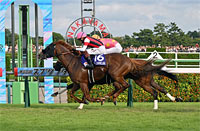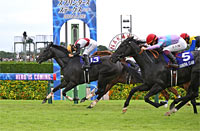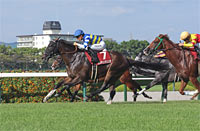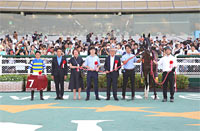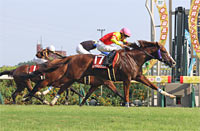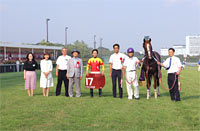Sprinters Stakes (G1) - Data Analysis
Ultimate contest for top sprinters
Of the 10 runners that won the JRA Award for Best Sprinter in 2008-2017, nine (excluding Maurice in 2015) finished in the Top 2 of the Sprinters Stakes of the corresponding year. The winner of last year’s Sprinters Stakes, Red Falx, also collected the award after receiving 264 votes out of 290. This suggests the Sprinters Stakes plays an important role in deciding which currently active runner deserves the title of fastest sprinter. In addition, the last winner to finish the Sprinters Stakes at least 1 length ahead of the runner-up was Curren Chan in 2011 (lead of 1¾ lengths). This means the last six races have been close contests won by less than a length. To determine which runner is most likely to take the crown in this fierce battle, let’s analyze some features shared by successful runners in this race based on results over the last 10 years, including the 1,200m race held at Niigata Racecourse in 2014.
Performance since the turn of the year is important
Of the 30 Top 3 finishers in the last 10 years, 14 had experience of winning “a 1,400m+ JRA race in the same year.” This group achieved a Top 3 ratio of 56.0%. Only three of the runners that entered the 2016 and 2017 Sprinters Stakes had such experience, but all three finished in the Top 3. Accordingly, it may be worth taking another look at horses with such a track record this year. [Table 1]
[Table 1] Performance by experience of winning “a 1,400m+ JRA race in the same year” (last 10 years)
| Experience of winning |
Performance
[1st-2nd-3rd-4th or lower] |
Win ratio |
Top 2 ratio |
Top 3 ratio |
| Yes |
5-5-4-11 |
20.0% |
40.0% |
56.0% |
| No |
5-5-6-119 |
3.7% |
7.4% |
11.9% |
Among the runners with no experience of winning “a 1,400m+ JRA race in the same year,” those that had also not experienced a Top 4 finish in “a JRA G1 race in the same year” struggled with a Top 3 ratio of only 6.3%. Runners that finished in the Top 2 of such a race were 2008 winner Sleepless Night and 2010 winner Ultra Fantasy (Hong Kong-trained horse contesting its first JRA race). In other words, we also need to watch performance in major races since the turn of the year. [Table 2]
[Table 2] Among runners with no experience of winning “a 1,400m+ JRA race in the same year,” performance by experience of Top 4 finish in “a JRA G1 race in the same year” (last 10 years)
| Experience |
Performance
[1st-2nd-3rd-4th or lower] |
Win ratio |
Top 2 ratio |
Top 3 ratio |
| Yes |
3-5-1-15 |
12.5% |
33.3% |
37.5% |
| No |
2-0-5-104 |
1.8% |
1.8% |
6.3% |
Watch finish and favoritism last time out
Of the 30 Top 3 finishers in the last 10 years, 21 finished their previous race in the Top 4. Meanwhile, runners that finished their previous race “5th or lower” have struggled somewhat with a Top 3 ratio of 11.0%. In other words, we should essentially watch runners that exhibited strong performance last time out [Table 3]
[Table 3] Performance by finish last time out (last 10 years)
Finish
last time out |
Performance
[1st-2nd-3rd-4th or lower] |
Win ratio |
Top 2 ratio |
Top 3 ratio |
| Top 4 |
7-7-7-57 |
9.0% |
17.9% |
26.9% |
| 5th or lower |
3-3-3-73 |
3.7% |
7.3% |
11.0% |
Of the 30 Top 3 finishers in the last 10 years, 26 contested “a domestic race” last time out and were backed as “4th favorite or higher” in that race. Conversely, runners that were backed as “5th favorite or lower” in such a race had a Top 3 ratio of only 4.8%. Accordingly, in addition to runners with strong finishes in their previous race, runners that were highly favored in their last outing should also be rated highly. [Table 4]
[Table 4] Among runners that contested “a domestic race” last time out, performance by favoritism (last 10 years)
Favoritism
last time out |
Performance
[1st-2nd-3rd-4th or lower] |
Win ratio |
Top 2 ratio |
Top 3 ratio |
4th favorite or
higher |
9-9-8-63 |
10.1% |
20.2% |
29.2% |
5th favorite or
lower |
0-1-2-59 |
0% |
1.6% |
4.8% |
Discount horses with a change of jockey
The 20 Top 2 finishers in the last 10 years were all horses ridden by the same jockey as in their previous outing. Horses that entered the race with a different jockey from their previous outing struggled with a Top 3 ratio of 8.1%. This suggests we should lower our expectations of horses ridden by a different jockey from their previous outing. [Table 5]
[Table 5] Performance by jockey (last 10 years)
| Jockey |
Performance
[1st-2nd-3rd-4th or lower] |
Win ratio |
Top 2 ratio |
Top 3 ratio |
Same jockey as
last time out |
10-10-5-73 |
10.2% |
20.4% |
25.5% |
Different jockey
from last time out |
0-0-5-57 |
0% |
0% |
8.1% |
Strong performance by fillies & mares in recent years
Of the 12 Top 3 finishers in the last four years, seven were fillies/mares. Although fillies and mares also delivered strong performance in earlier years, their success ratios have been particularly high in recent years, so we should definitely take this into account. [Table 6]
[Table 6] Performance by gender (last 4 years)
| Gender |
Performance
[1st-2nd-3rd-4th or lower] |
Win ratio |
Top 2 ratio |
Top 3 ratio |
| Colts or geldings |
3-2-0-38 |
7.0% |
11.6% |
11.6% |
| Mares |
1-2-4-15 |
4.5% |
13.6% |
31.8% |
Expect little from front runner-type horses
Of the 12 Top 3 finishers in the last four years, 11 contested “a domestic race” last time out and were in “3rd position or lower” when passing the 4th corner in that race. Meanwhile, runners that were in “2nd position or higher” when passing the 4th corner produced zero Top 2 finishers and had a Top 3 ratio of only 7.1%. Prior to 2013, runners that were in “2nd position or higher” when passing the 4th corner in their previous race delivered strong performances, but we should lower our expectations of such runners if trends in recent years are anything to go by. [Table 7]
[Table 7] Among runners that contested “a domestic race” last time out, performance by position when passing 4th corner in that race (last 4 years)
Position when passing
4th corner in previous race |
Performance
[1st-2nd-3rd-4th or lower] |
Win ratio |
Top 2 ratio |
Top 3 ratio |
| 2nd position or higher |
0-0-1-13 |
0% |
0% |
7.1% |
| 3rd position or lower |
4-4-3-34 |
8.9% |
17.8% |
24.4% |
Note: Excluding runners that contested a 1,000m turf race at Niigata Racecourse last time out
Seek out the winner!
Majority of winners have been 4 to 6-year-olds
The four last winners were all 5 or 6-year-olds. In addition, looking back at the last 18 races since 2000, when the race was moved to the current racing calendar, we observe that winners have often been 4 to 6-year-olds. The only 3-year-old to have triumphed since 2000 was Aston Machan in 2007, and the only two horses 7-year-olds or older that won the race were Takeover Target (7yo) in 2006 and Ultra Fantasy (8yo) in 2010. In other words, it would seem wise to focus on 4 to 6-year-olds. Other statistics shared by the four last winners are that they were among the Top 4 favorites in their last outing, that they were ridden by the same jockey as in their last outing, and that they were in 8th position or lower when passing the 4th corner in their previous race. This means we should also take into account the trends highlighted in Tables 4, 5, and 7. [Table 8]
[Table 8] Winners’ “age,” “favoritism in previous race,” “jockey in Sprinters Stakes,” “jockey in previous race,” “position when passing 4th corner in previous race” (last 4 years)
| Year |
Winner |
Age |
Favoritism in
previous race |
Jockey in
Sprinters Stakes |
Jockey in
previous race |
Position when
passing 4th corner
in previous race |
| 2014 |
Snow Dragon |
6 |
4th favorite |
Takuya Ono |
Takuya Ono |
13th |
| 2015 |
Straight Girl |
6 |
3rd favorite |
Keita Tosaki |
Keita Tosaki |
8th |
| 2016 |
Red Falx |
5 |
3rd favorite |
Mirco Demuro |
Mirco Demuro |
9th |
| 2017 |
Red Falx |
6 |
3rd favorite |
Mirco Demuro |
Mirco Demuro |
13th |
(Masaya Ibuki)
|
















